Razer Phone 2 vs Asus ROG Phone: choose your weapon

2018 has been the year of the gaming smartphone as manufacturers jumped aboard the bandwagon Battle Bus to offer devices specialized for gaming. Standing at the top of the pile are two devices from established gaming brands: the Razer Phone 2 and the Asus ROG Phone.
I've already reviewed the devices in detail, but here we'll get into the specific pros and cons between them. Gamers will already be familiar with having a choice between characters or loadouts with different strengths and weaknesses to complete a mission. So it is the case here: both devices are more than capable of getting the job done, but the difference in the special details is what can make one right for you. So let's compare our contenders.
Design: corners or curves?
Razer and ROG are both established gaming hardware manufacturers who bring a distinctive 'gamer lifestyle' look to their devices, making them stand out next to any mainstream manufacturer, but also from each other. The Razer Phone 2 is positively restrained and minimalist, a shiny black rectangular bar in 16:9 with hard edges and thick bezels that double as speaker grills. It's a strange, distinctive design that often drew remarks when I drew the device in public.
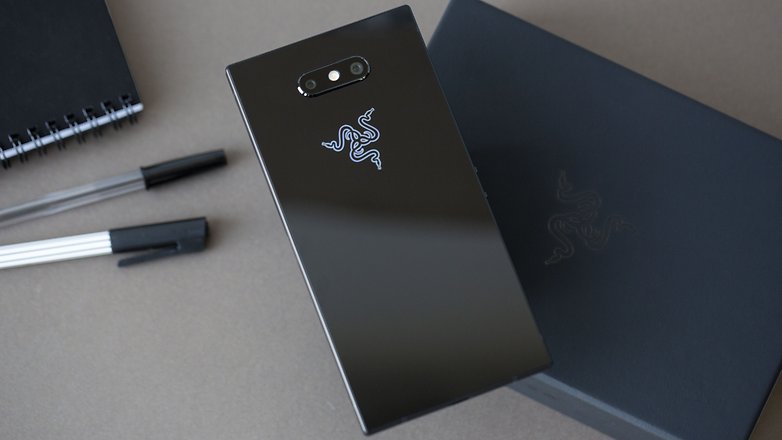
Meanwhile, the Asus ROG Phone manages to be both mainstream-looking and aggressively 'gamer' all at once. It has rounded corners and an 18:9 aspect ratio just like other normal flagships, with cool copper accents on the front speakers, but it's a different story on the back, which gets quite 'busy' with jagged, asymmetrical angular lines everywhere.
Both devices have customizable RGB light-up logos on the back. Overall, I prefer the minimalist look and symmetry of Razer's black block, which I feel is more nicely accentuated by the RGB logo. But it's a matter of taste, your mileage may vary.

One thing to consider about the design is aesthetics, but another is practicality. I personally find the shape and dimensions of the Razer Phone 2 frustrating because, like its predecessor, it's rectangular shape is awkward to use one-handed and uncomfortable in the pocket. But...hold it in landscape for gaming, and the edges actually make it feel much more secure in the grip.
But for daily ease of use, I'd have to say that the ROG Phone's shape, while less unique, is easier to use in everyday life, both in hand and in pocket. A gaming smartphone still has to be a smartphone, so when choosing one as my daily driver, the ROG Phone (ironically) has the edge.
Display: is speed all you need?
Here's an interesting dilemma. An LCD display with up to 120Hz refresh rate or an AMOLED panel locked at 90Hz? Not gonna lie, the Razer's refresh rate is a delight, not just when gaming, but also makes everyday scrolling through feeds and opening app seem much smoother too. Razer may have the fastest smartphone display, but the ROG Phone still boasts the fasted OLED, so if you want deeper, richer colors and blacks, the ROG is the way to go, and it doesn't feel sluggish.
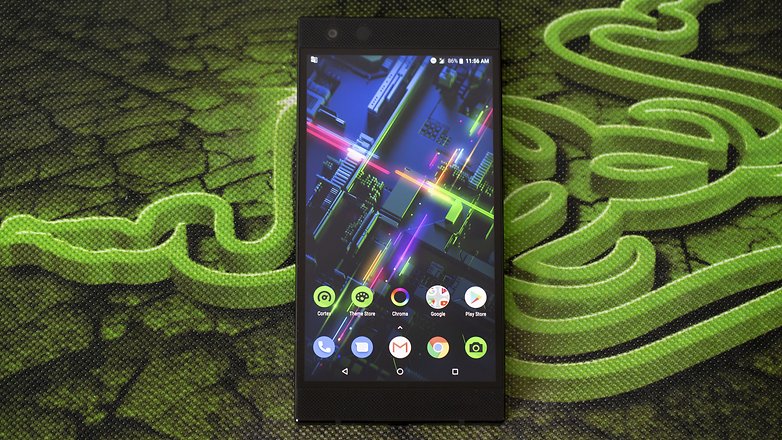
But it's not just about speed, Razer also wins at resolution (2560 x 1440) and the slighter smaller screen on the Razer Phone 2 means you get a higher pixel density, too (513ppi). The Asus ROG Phone has a 2160 x 1080 resolution and 402ppi.
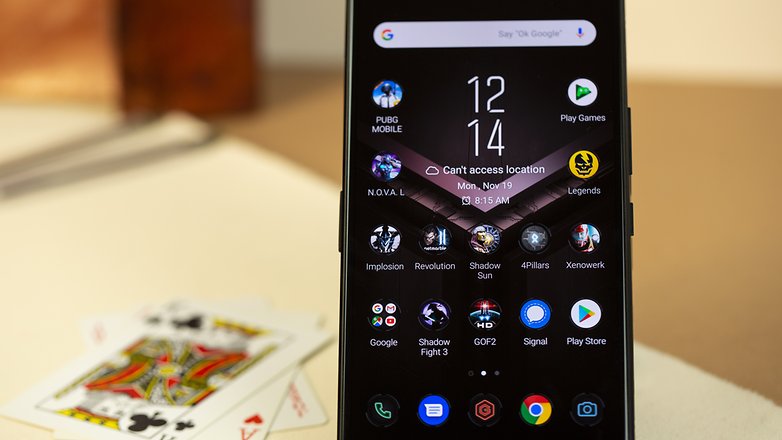
If you're into intense competitive gaming, you should still consider the Razer device if only because the extra fps offered by the refresh rate can mean the difference between victory and defeat in esports...provided that the game supports that rate. Fortnite, for example, is still capped at 60fps. But the number of 120Hz compatible mobile games is growing all the time. Razer, of course, is keen to promote these, and competitive titles such as Tekken Mobile and Shadowgun Legends are among them.
By the numbers: game and performance
Asus ROG Phone vs. Razer Phone 2 technical specifications
| Asus ROG Phone | Razer Phone 2 | |
|---|---|---|
| Dimensions: | 158.83 x 76.16 x 8.65 mm | 158.5 x 78.99 x 8.5 mm |
| Weight: | 200 g | 222 g |
| Battery size: | 4000 mAh | 4000 mAh |
| Screen size: | 6 in | 5.72 in |
| Display technology: | AMOLED | LCD |
| Screen: | 2160 x 1080 pixels (402 ppi) | 2560 x 1440 pixels (513 ppi) |
| Front camera: | 8 megapixels | 8 megapixels |
| Rear camera: | 12 megapixels | 12 megapixels |
| Flashlight: | LED | Dual-LED |
| Android version: | 8.0 - Oreo | 8.1 - Oreo |
| RAM: | 8 GB | 8 GB |
| Internal storage: | 512 GB 128 GB |
64 GB |
| Removable storage: | Sorry, not yet available! | microSD |
| Chipset: | Qualcomm Snapdragon 845 | Qualcomm Snapdragon 845 |
| Number of cores: | 8 | 8 |
| Max. clock speed: | 2.96 GHz | 2.8 GHz |
| Connectivity: | HSPA, LTE, NFC, Dual-SIM , Bluetooth 5.0 | HSPA, LTE, NFC, Bluetooth 5.0 |
When it comes to hardware, both phones are top performers in the (spec) sheets, but the Asus Phone can boast of a special 'speed-binned' Snapdragon 845 SoC overclocked to 2.96GHz top speed. But anyway, something about the motion of the ocean: does this make a difference in everyday gaming? Not that I noticed. Both can run the most demanding mobile games for long sessions without breaking much of a sweat. Both have specialized cooling systems that keep the phone from getting too hot in the hand.
ROG Phone vs Razer Phone 2: benchmark comparison
| Smartphone | 3D Mark Sling Shot Extreme ES 3.1 | 3D Mark Sling Shot ES 3.0 | 3D Mark Ice Storm Unlimited ES 2.0 | Geekbench 4 - single core | Geekbench 4 - multi core |
|---|---|---|---|---|---|
| Asus ROG Phone | 4376 | 4963 | 62481 | 1528 | 6627 |
| Razer Phone 2 | 4001 | 5084 | 63325 | 2352 | 7953 |
| OnePlus 6 | 4073 | 5583 | 62113 | 2448 | 8970 |
| Samsung Galaxy S9+ | 3257 | 3910 | 38302 | 3771 | 8923 |
A much more noticeable advantage of the ROG device is a nice roomy 128GB storage space, or 512GB in the deluxe version. 64GB on the Razer may sound like a lot but with modern high-end mobile games often taking up 2-3GB space (and don't forget, many are live services which depend on regular updates), it can fill up sooner than you think. Sure, you can manage your storage by juggling your apps, uninstalling and so on. But it's nice not to have to think about it, especially if you're storing video on top of apps.
On, the other hand, if you handle tons of data on microSD cards, then the advantage flips to Razer, because the Razer Phone 2 supports microSD, but the ROG Phone does not. The Asus Phone sacrifices this in favor of being dual-SIM.
Software: is less more?
Both phones come with dedicated software (ROG Game Center vs Razer Cortex) to help you manage your gaming and balance it with battery life, including graphical settings and hardware resource allocation. Here again Razer wins me over with elegance and minimalism...based on near stock Android UI with Nova Launcher, both the specialized Razer apps and overall use feel cleaner, more intuitive and easier to organize.

The ROG Phone has a nice extra in the form of Game Genie, easily accessed via a side swipe during games, that comes with a host of options such as toggling AirTriggers, overlaying usage stats and live-streaming. Not everyone is going to need this, though, and if you don't, then I'd say Razer nets the better overall Android experience in daily use.
Powerful speakers, but it's headphones you should consider
Both devices have front-facing speakers, with the Razer Phone 2's being more powerful overall, possibly the loudest smartphone speakers in existence. But the ROG is no slouch, and only lags behind by a touch on full blast. Unless your phone is your main music speaker, it's not enough to be a deciding factor.
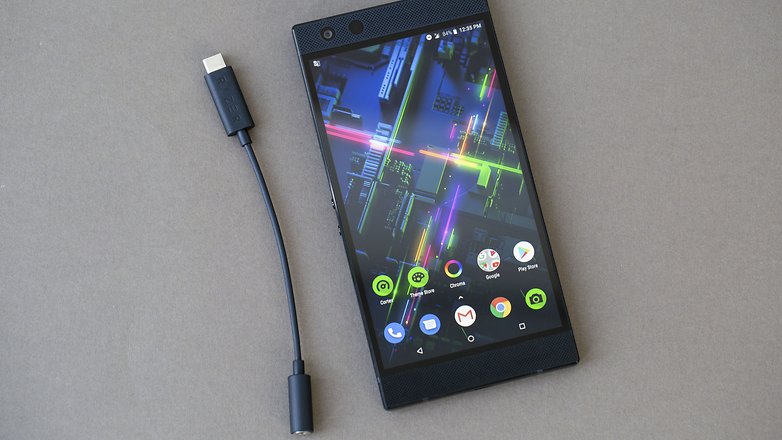
One thing about the Razer's speakers - you've got to be careful to keep them clean! Even though they are covered compared the first one, they still trap dust very easily, which is difficult to clean and not a nice look at all.
Instead, consider your headphone habits. Mainly, if you prefer to use wired headphones. Only the ROG comes with a 3.5mm jack. Razer fans have got to dongle up, but there's one included in the box.
Gimmicks galore
Razer's arsenal is looking a little sparse in this round. The Razer Phone 2 supports wireless charging, but you'll need a separate charger for that. Razer's own Chroma-lit one is $99 extra. The ROG Phone doesn't charge wirelessly, but it still has plenty to deploy.
Face recognition is one advantage of the ROG, but it also has some unique characteristics. I found the ultrasonic AirTrigger buttons responsive enough in my tests, but they felt far from essential...I wouldn't bother to use them in most cases unless future titles offered explicit support for them.
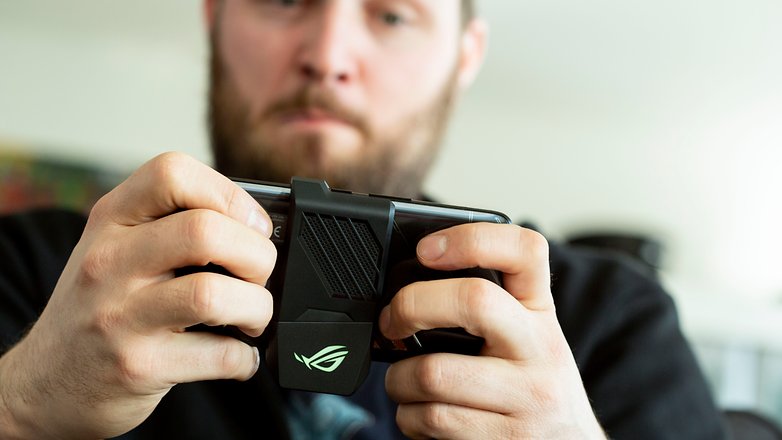
The included clip-on fan/port is also a nice-to-have that didn't see so much use from me. It's good for hours-long gaming sessions at home, especially because it keeps the headphones and charging cable away from your fingers. Very useful if the smartphone is your main gaming device, but not so much if it's just a sidearm to your main PC/console.
Future accessories such as Razer's Raiju mobile controller and ROG's Twin Deck weren't available to try at the time of writing, but we look forward to assessing them in future articles.
The bottom line
As much as I appreciate both devices, when it comes to picking up one to serve as my daily driver, I reached for the ROG. Its ease of use in daily life coupled with all the extra bells and whistles made it a better all-rounder than the Razer, even if I felt the latter was more elegant in design and software. But those extras cost you, to the tune of $899 for the 128GB version.
The Razer Phone 2 is $100 cheaper, and thanks to the faster higher-res display, can still stick its tongue out at Asus. How significant that point plus the price advantage is, weighed against the other extras of the ROG phone, will probably be the deciding factor.
What do you think of these two gaming smartphones?



